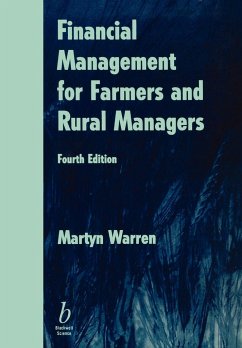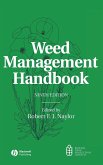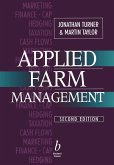Martyn Warren
Financial Management for Farmers 4e
Martyn Warren
Financial Management for Farmers 4e
- Broschiertes Buch
- Merkliste
- Auf die Merkliste
- Bewerten Bewerten
- Teilen
- Produkt teilen
- Produkterinnerung
- Produkterinnerung
This book is a practical guide to all aspects of financial management in the smaller business. Although the prime focus is on owners and managers of farm businesses and farm diversifications, it is equally valuable for other types of rural business and organisation. It has proved popular on degree and diploma courses in Rural Resource Management, Countryside Management and Rural Estate Management, as well as those concerned with Agriculture. In this fourth edition, increased emphasis has been given to general accounting
Andere Kunden interessierten sich auch für
![Weed Management Handbook 9e Weed Management Handbook 9e]() Weed Management Handbook 9e345,99 €
Weed Management Handbook 9e345,99 €![Applied Farm Management Applied Farm Management]() Jonathan TurnerApplied Farm Management124,99 €
Jonathan TurnerApplied Farm Management124,99 €![Fruit Breeding, Vine and Small Fruits Fruit Breeding, Vine and Small Fruits]() Fruit Breeding, Vine and Small Fruits417,99 €
Fruit Breeding, Vine and Small Fruits417,99 €![Fruit Breeding, Tree and Tropical Fruits Fruit Breeding, Tree and Tropical Fruits]() Fruit Breeding, Tree and Tropical Fruits420,99 €
Fruit Breeding, Tree and Tropical Fruits420,99 €![Biology and Management of Rice Insects Biology and Management of Rice Insects]() Biology and Management of Rice Insects563,99 €
Biology and Management of Rice Insects563,99 €![Farm Business Management Farm Business Management]() Peter L NuthallFarm Business Management250,99 €
Peter L NuthallFarm Business Management250,99 €![Aquaculture of the United States Aquaculture of the United States]() Robert R StickneyAquaculture of the United States362,99 €
Robert R StickneyAquaculture of the United States362,99 €-
-
-
This book is a practical guide to all aspects of financial management in the smaller business. Although the prime focus is on owners and managers of farm businesses and farm diversifications, it is equally valuable for other types of rural business and organisation. It has proved popular on degree and diploma courses in Rural Resource Management, Countryside Management and Rural Estate Management, as well as those concerned with Agriculture. In this fourth edition, increased emphasis has been given to general accounting
Hinweis: Dieser Artikel kann nur an eine deutsche Lieferadresse ausgeliefert werden.
Hinweis: Dieser Artikel kann nur an eine deutsche Lieferadresse ausgeliefert werden.
Produktdetails
- Produktdetails
- Verlag: Wiley
- 4th Revised edition
- Seitenzahl: 308
- Erscheinungstermin: 4. Februar 1998
- Englisch
- Abmessung: 244mm x 170mm x 17mm
- Gewicht: 535g
- ISBN-13: 9780632048717
- ISBN-10: 0632048719
- Artikelnr.: 21739282
- Herstellerkennzeichnung
- Libri GmbH
- Europaallee 1
- 36244 Bad Hersfeld
- gpsr@libri.de
- Verlag: Wiley
- 4th Revised edition
- Seitenzahl: 308
- Erscheinungstermin: 4. Februar 1998
- Englisch
- Abmessung: 244mm x 170mm x 17mm
- Gewicht: 535g
- ISBN-13: 9780632048717
- ISBN-10: 0632048719
- Artikelnr.: 21739282
- Herstellerkennzeichnung
- Libri GmbH
- Europaallee 1
- 36244 Bad Hersfeld
- gpsr@libri.de
Debra Warren has written several area history books for Illinois communities and entities. She has a master's degree from the University of Chicago's School of Social Work, Policy, and Practice and is a Licensed Clinical Social Worker and Board Certified Diplomate. Debra currently resides in Lake Forest, Illinois with her family. Connect with her on Twitter @Brandwearer1
Part 1 Basic Issues: Why bother?
In the beginning...
Building a framework
Cash Flow, Profit and Capital: Cash flow
Net Profit
Profit statements
Capital
Capital Statements
Depreciation
Interpretation of Financial Accounts: Adjusting for realism
Interpreting the profit and loss account
Interpreting the balance sheet
Management Accounts: Management versus financial accounts
Gross margin accounts
Full cost accounts
Allowing for cost behaviour
Pricing
Variations from the Norm: Farm management accounting
Partnerships and companies
Voluntary/non-profit organizations
Part 2: Basic Budgeting: A profit budget: Introduction
Compiling a profit budget
Home Farm profit budget
A Cash Flow Budget for the Whole Farm: Basic principles
Value Added Tax and overdraft interest
Cash flow budgets in practice
Reconciling cash flow and profit
A Budgeted Balance Sheet: Compiling the budget
A budgeted balance sheet for Home Farm
Budgeting for Incremental Change: Relevant costs and benefits
Partial budgets
Part 3 Financial History: Recording Cash Flow: Designing a cash recording system
The cash analysis system
Petty cash
Statutory records
Recording Profit and Capital: Preparing a profit and loss account
Valuing stocks
Recording capital
The 'Back-up' Records: Introduction
Transaction records
Physical records
Stock control
Background records
Organizing paperwork
Post-script
Part 4: Controlling the Business: Monitoring Cash Flow: Why monitor cash flow?
Comparison of actual and budgeted results
Interpreting the results
Annual cash flow monitoring
Monitoring Profit and Capital: The importance of monitoring profit
Comparison with previous years
Inter-farm comparisons (1): conventional profit and loss account
inter-farm comparisons (2): profit and loss accounts in enterprise account form
Budgetary comparisons
Variance analysis
profit monitoring for Home Farm
Monitoring capital
Part 5: More on Planning and Control: The Planning Process - A Wider View: Tactics and strategy
The mission
Setting aims and objectives
Assessing 'internal' characteristics and external environment
Generating alternative plans
Selecting the optimal plan
Implementing and monitoring the selected plan
Involving other members of the organization
Planning for Livestock Enterprises: Introduction
Feeding livestock
Allocation of forage costs
Estimating potential production
Replacement of breeding livestock
Livestock with long production cycles
Labour and Machinery Planning in Farming: Introduction
Estimating level of use
Estimating labour and machinery costs
Investigating alternatives
Capital Planning: Introdiction
Sources of capital
Estimating the cost of capital
Comparing alternative uses of capital (1): simple measures
Comparing alternative uses of capital (2): discounted cash flow techniques
Allowing for Risk and Uncertainty: Introduction
Allowing for risk and uncertainty in planning
Risk and investment appraisal
Allowing for Inflation: Introduction
Inflation and financial accounts
Inflation and management accounts
Inflation and planning
Inflation and investment appraisal
Appendix A. Personal Computers in Management: A.1 Introduction
A.2 Computers and farming
A.3 General business applications
In the beginning...
Building a framework
Cash Flow, Profit and Capital: Cash flow
Net Profit
Profit statements
Capital
Capital Statements
Depreciation
Interpretation of Financial Accounts: Adjusting for realism
Interpreting the profit and loss account
Interpreting the balance sheet
Management Accounts: Management versus financial accounts
Gross margin accounts
Full cost accounts
Allowing for cost behaviour
Pricing
Variations from the Norm: Farm management accounting
Partnerships and companies
Voluntary/non-profit organizations
Part 2: Basic Budgeting: A profit budget: Introduction
Compiling a profit budget
Home Farm profit budget
A Cash Flow Budget for the Whole Farm: Basic principles
Value Added Tax and overdraft interest
Cash flow budgets in practice
Reconciling cash flow and profit
A Budgeted Balance Sheet: Compiling the budget
A budgeted balance sheet for Home Farm
Budgeting for Incremental Change: Relevant costs and benefits
Partial budgets
Part 3 Financial History: Recording Cash Flow: Designing a cash recording system
The cash analysis system
Petty cash
Statutory records
Recording Profit and Capital: Preparing a profit and loss account
Valuing stocks
Recording capital
The 'Back-up' Records: Introduction
Transaction records
Physical records
Stock control
Background records
Organizing paperwork
Post-script
Part 4: Controlling the Business: Monitoring Cash Flow: Why monitor cash flow?
Comparison of actual and budgeted results
Interpreting the results
Annual cash flow monitoring
Monitoring Profit and Capital: The importance of monitoring profit
Comparison with previous years
Inter-farm comparisons (1): conventional profit and loss account
inter-farm comparisons (2): profit and loss accounts in enterprise account form
Budgetary comparisons
Variance analysis
profit monitoring for Home Farm
Monitoring capital
Part 5: More on Planning and Control: The Planning Process - A Wider View: Tactics and strategy
The mission
Setting aims and objectives
Assessing 'internal' characteristics and external environment
Generating alternative plans
Selecting the optimal plan
Implementing and monitoring the selected plan
Involving other members of the organization
Planning for Livestock Enterprises: Introduction
Feeding livestock
Allocation of forage costs
Estimating potential production
Replacement of breeding livestock
Livestock with long production cycles
Labour and Machinery Planning in Farming: Introduction
Estimating level of use
Estimating labour and machinery costs
Investigating alternatives
Capital Planning: Introdiction
Sources of capital
Estimating the cost of capital
Comparing alternative uses of capital (1): simple measures
Comparing alternative uses of capital (2): discounted cash flow techniques
Allowing for Risk and Uncertainty: Introduction
Allowing for risk and uncertainty in planning
Risk and investment appraisal
Allowing for Inflation: Introduction
Inflation and financial accounts
Inflation and management accounts
Inflation and planning
Inflation and investment appraisal
Appendix A. Personal Computers in Management: A.1 Introduction
A.2 Computers and farming
A.3 General business applications
Part 1 Basic Issues: Why bother?
In the beginning...
Building a framework
Cash Flow, Profit and Capital: Cash flow
Net Profit
Profit statements
Capital
Capital Statements
Depreciation
Interpretation of Financial Accounts: Adjusting for realism
Interpreting the profit and loss account
Interpreting the balance sheet
Management Accounts: Management versus financial accounts
Gross margin accounts
Full cost accounts
Allowing for cost behaviour
Pricing
Variations from the Norm: Farm management accounting
Partnerships and companies
Voluntary/non-profit organizations
Part 2: Basic Budgeting: A profit budget: Introduction
Compiling a profit budget
Home Farm profit budget
A Cash Flow Budget for the Whole Farm: Basic principles
Value Added Tax and overdraft interest
Cash flow budgets in practice
Reconciling cash flow and profit
A Budgeted Balance Sheet: Compiling the budget
A budgeted balance sheet for Home Farm
Budgeting for Incremental Change: Relevant costs and benefits
Partial budgets
Part 3 Financial History: Recording Cash Flow: Designing a cash recording system
The cash analysis system
Petty cash
Statutory records
Recording Profit and Capital: Preparing a profit and loss account
Valuing stocks
Recording capital
The 'Back-up' Records: Introduction
Transaction records
Physical records
Stock control
Background records
Organizing paperwork
Post-script
Part 4: Controlling the Business: Monitoring Cash Flow: Why monitor cash flow?
Comparison of actual and budgeted results
Interpreting the results
Annual cash flow monitoring
Monitoring Profit and Capital: The importance of monitoring profit
Comparison with previous years
Inter-farm comparisons (1): conventional profit and loss account
inter-farm comparisons (2): profit and loss accounts in enterprise account form
Budgetary comparisons
Variance analysis
profit monitoring for Home Farm
Monitoring capital
Part 5: More on Planning and Control: The Planning Process - A Wider View: Tactics and strategy
The mission
Setting aims and objectives
Assessing 'internal' characteristics and external environment
Generating alternative plans
Selecting the optimal plan
Implementing and monitoring the selected plan
Involving other members of the organization
Planning for Livestock Enterprises: Introduction
Feeding livestock
Allocation of forage costs
Estimating potential production
Replacement of breeding livestock
Livestock with long production cycles
Labour and Machinery Planning in Farming: Introduction
Estimating level of use
Estimating labour and machinery costs
Investigating alternatives
Capital Planning: Introdiction
Sources of capital
Estimating the cost of capital
Comparing alternative uses of capital (1): simple measures
Comparing alternative uses of capital (2): discounted cash flow techniques
Allowing for Risk and Uncertainty: Introduction
Allowing for risk and uncertainty in planning
Risk and investment appraisal
Allowing for Inflation: Introduction
Inflation and financial accounts
Inflation and management accounts
Inflation and planning
Inflation and investment appraisal
Appendix A. Personal Computers in Management: A.1 Introduction
A.2 Computers and farming
A.3 General business applications
In the beginning...
Building a framework
Cash Flow, Profit and Capital: Cash flow
Net Profit
Profit statements
Capital
Capital Statements
Depreciation
Interpretation of Financial Accounts: Adjusting for realism
Interpreting the profit and loss account
Interpreting the balance sheet
Management Accounts: Management versus financial accounts
Gross margin accounts
Full cost accounts
Allowing for cost behaviour
Pricing
Variations from the Norm: Farm management accounting
Partnerships and companies
Voluntary/non-profit organizations
Part 2: Basic Budgeting: A profit budget: Introduction
Compiling a profit budget
Home Farm profit budget
A Cash Flow Budget for the Whole Farm: Basic principles
Value Added Tax and overdraft interest
Cash flow budgets in practice
Reconciling cash flow and profit
A Budgeted Balance Sheet: Compiling the budget
A budgeted balance sheet for Home Farm
Budgeting for Incremental Change: Relevant costs and benefits
Partial budgets
Part 3 Financial History: Recording Cash Flow: Designing a cash recording system
The cash analysis system
Petty cash
Statutory records
Recording Profit and Capital: Preparing a profit and loss account
Valuing stocks
Recording capital
The 'Back-up' Records: Introduction
Transaction records
Physical records
Stock control
Background records
Organizing paperwork
Post-script
Part 4: Controlling the Business: Monitoring Cash Flow: Why monitor cash flow?
Comparison of actual and budgeted results
Interpreting the results
Annual cash flow monitoring
Monitoring Profit and Capital: The importance of monitoring profit
Comparison with previous years
Inter-farm comparisons (1): conventional profit and loss account
inter-farm comparisons (2): profit and loss accounts in enterprise account form
Budgetary comparisons
Variance analysis
profit monitoring for Home Farm
Monitoring capital
Part 5: More on Planning and Control: The Planning Process - A Wider View: Tactics and strategy
The mission
Setting aims and objectives
Assessing 'internal' characteristics and external environment
Generating alternative plans
Selecting the optimal plan
Implementing and monitoring the selected plan
Involving other members of the organization
Planning for Livestock Enterprises: Introduction
Feeding livestock
Allocation of forage costs
Estimating potential production
Replacement of breeding livestock
Livestock with long production cycles
Labour and Machinery Planning in Farming: Introduction
Estimating level of use
Estimating labour and machinery costs
Investigating alternatives
Capital Planning: Introdiction
Sources of capital
Estimating the cost of capital
Comparing alternative uses of capital (1): simple measures
Comparing alternative uses of capital (2): discounted cash flow techniques
Allowing for Risk and Uncertainty: Introduction
Allowing for risk and uncertainty in planning
Risk and investment appraisal
Allowing for Inflation: Introduction
Inflation and financial accounts
Inflation and management accounts
Inflation and planning
Inflation and investment appraisal
Appendix A. Personal Computers in Management: A.1 Introduction
A.2 Computers and farming
A.3 General business applications








